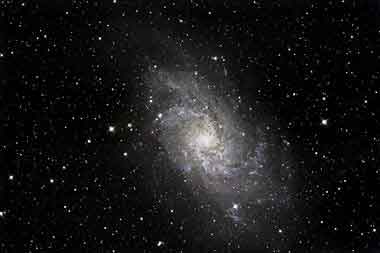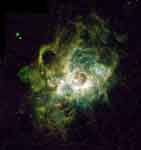- ^ a b c d e f g h i j NASA/IPAC Extragalactic Database. Results for NGC 598. Retrieved on 2006-12-01.
- ^ a b I. D. Karachentsev, V. E. Karachentseva, W. K. Hutchmeier, D. I. Makarov (2004). "A Catalog of Neighboring Galaxies". Astronomical Journal 127: 2031-2068. doi:10.1086/382905.
- ^ a b Karachentsev, I. D.; Kashibadze, O. G. (2006). "Masses of the local group and of the M81 group estimated from distortions in the local velocity field". Astrophysics 49 (1): 3-18. doi:10.1007/s10511-006-0002-6.
- ^ a b Bonanos, A. Z.; Stanek, K. Z.; Kudritzki, R. P.; Macri, L.; Sasselov, D. D.; Kaluzny, J.; Bersier, D.; Bresolin, F.; Matheson, T.; Mochejska, B. J.; Przybilla, N.; Szentgyorgyi, A. H.; Tonry, J.; Torres, G. (2006). "The First DIRECT Distance to a Detached Eclipsing Binary in M33". Astrophysics and Space Science Online First.
- ^ a b average(850 ± 40, 940 ± 70) = ((850 + 940) / 2) ± ((40² + 70²)0.5 / 2) = 895 ± 40
- ^ SIMBAD astronomical database. Results for M33. Retrieved on 2007-04-30.
- ^ a b S. J. O'Meara (1998). The Messier Objects. Cambridge: Cambridge University. ISBN 0-521-55332-6.
- ^ NASA Spitzer Telescope Reveals Pinwheel Galaxy's Hidden Wonders. Retrieved on 2007-04-07.
- ^ SIMBAD Astronomical Database. Results for Messier 101.. Retrieved on 2007-04-07.
- ^ Messier Object 101. Retrieved on 2007-04-07.
- ^ Best of AOP: M101: Pinwheel Galaxy. Retrieved on 2007-04-07.
- ^ Brunthaler, Andreas; Reid, Mark J.; Falcke, Heino; Greenhill, Lincoln J.; Henkel, Christian (2005). "The Geometric Distance and Proper Motion of the Triangulum Galaxy (M33)". Science 307 (5714): 1440-1443. doi:10.1126/science.1108342.
- ^ Morcone, Jennifer, Heaviest Stellar Black Hole Discovered in Nearby Galaxy, Chandra X-ray Observatory press release, 2007-10-17
- ^ Ho, Luis C.; Filippenko, Alexei V. & Sargent, Wallace L. W. (October 1997), "A Search for "Dwarf" Seyfert Nuclei. III. Spectroscopic Parameters and Properties of the Host Galaxies", Astrophysical Journal Supplement 112: 315-390
The Triangulum Galaxy (also known as Messier 33 or NGC 598) is a spiral galaxy approximately 3 million light-years away in the constellation Triangulum. The galaxy is also sometimes informally referred to as the Pinwheel Galaxy by some amateur astronomy references [7] and in some public outreach websites.[8] However, the SIMBAD Astronomical Database, a professional astronomy database that contains formal designations for astronomical objects, indicates that the name "Pinwheel Galaxy" is used to refer to Messier 101, [9] and several other amateur astronomy resources and other public outreach websites also identify Messier 101 by that name.[10][11] It is the third largest galaxy in the Local Group, a group of galaxies that also contains the Milky Way Galaxy and the Andromeda Galaxy, and it may be a gravitationally bound companion of the Andromeda Galaxy. The Pisces Dwarf (LGS 3), one of the small Local Group member galaxies, is possibly a satellite of Triangulum. General information The Triangulum Galaxy can be seen with the naked eye under exceptionally good conditions. While the fainter and more distant galaxy Messier 81 has also been seen with the naked eye by very experienced observers, M33 is often considered the most distant object that can be seen without aid. [7] However, some amateur astronomers may confuse the object with the nearby NGC 752, an open cluster that is brighter than the Triangulum Galaxy.[citation needed] No known pre-telescopic observer notes it, which is not surprising: given its indistinctness, it is not likely to be noticed as an object unless one already knows of its existence. The Triangulum Galaxy was probably discovered by Giovanni Batista Hodierna before 1654, who may have grouped it together with open cluster NGC 752. It was independently discovered by Charles Messier in 1764, who catalogued it as M33 on August 25. M33 was also catalogued independently by William Herschel on September 11, 1784 number H V.17. It was among the first "spiral nebulae" identified as such by Lord Rosse. Herschel also cataloged The Triangulum Galaxy's brightest and largest H II region (diffuse emission nebula containing ionized hydrogen) as H III.150 separately from the galaxy itself, which eventually obtained NGC number 604. As seen from Earth NGC 604 is located northeast of the galaxy's central core, and is one of the largest H II regions known with a diameter of nearly 1500 light-years and a spectrum similar to the Orion Nebula. Herschel also noted 3 other smaller H II regions (NGC 588, 592 and 595). In 2005, using observations of two water masers on opposite sides of Triangulum via the VLBA, researchers were, for the first time, able to estimate the angular rotation and proper motion of Triangulum. A velocity of 190 ± 60 km/s relative to the Milky Way is computed which gives the velocity that Triangulum is moving towards Andromeda.[12] In 2007, a black hole about 15.7 times the mass of the Sun was detected in the galaxy using data from the Chandra X-ray Observatory. The black hole, named M33 X-7, orbits a companion star which it eclipses every 3.5 days. [13] The galaxy has an H II nucleus.[14]
NGC 604 in the Triangulum Galaxy is a very massive open cluster surrounded by an H II region. Credit: NASA/ESA. Distance At least two techniques have been used to measure distances to M 33. Using the Cepheid variable method, an estimate of 2.77 ± 0.13 Mly (850 ± 40 kpc) was achieved in 2004.[2][3] In 2006, a group of astronomers announced the discovery of an eclipsing binary star in the Triangulum Galaxy. By studying the eclipses of the stars, the astronomers were able to measure their sizes. Knowing the sizes and temperatures of the stars they were able to measure the absolute magnitude of the stars. When the visual and absolute magnitudes are known, the distance to the star can be measured. The stars lie at the distance of 3.1 ± 0.2 Mly (940 ± 70 kpc).[4] Averaged together, all these distance measurements give a combined distance estimate of 2.92 ± 0.13 Mly (895 ± 40 kpc).[5] References Links Retrieved from "http://en.wikipedia.org/"
|
|
|||||||||||||||||||||||||||||||||



